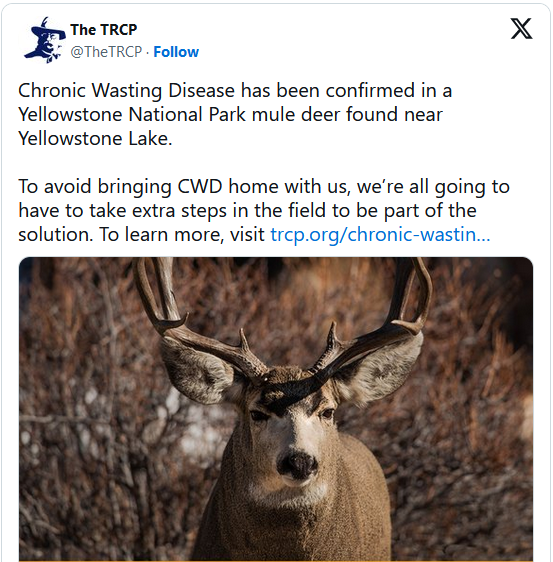The Death of Hamas Leader Yahya Sinwar: What We Know So Far
Israel and the US claim intelligence provided Sinwar’s whereabouts, but this is doubtful.
Loading...
Chronic wasting disease poses a risk of spreading to humans in Yellowstone National Park. "Zombie deer disease," which scientists call "slow-moving flake," is spreading across the United States after it was discovered in Yellowstone National Park.
This fatal disease has no cure and is most common in deer and elk. However, studies have shown that the disease can also spread to humans. Here's what we know about this disease and whether people should be concerned.
What is zombie deer disease? According to the US National Health Service's Centers for Disease Control and Prevention (CDC), zombie deer is a chronic wasting disease (CWD) that first appeared in deer, elk, caribou, sika deer, and elk. It is not known how the name "zombie deer" came about. This eats away at the animal's brain, causing symptoms similar to dementia and eventually leading to death. There is no cure or vaccine. CWD is virtually indestructible and is spread by prions, a series of proteins that affect both animals and humans. It rarely causes some type of progressive neurodegenerative disorder. That is, it affects the nervous system and gradually worsens. The World Health Organization (WHO) has called for known prion disease pathogens, such as animals infected with zombie deer disease, to be prevented from entering the human food chain. However, there is no clear evidence that humans can be infected with CWD prions from animals.
What are the symptoms of zombie deer disease?
The prions in this disease cause abnormal folding and clumping of cells in the brain and spinal cord. About a year after infection, animals develop symptoms including dementia, tremors, drooling, aggression, and weight loss.
Where was the zombie deer disease discovered? The National Park Service said in mid-November that a deer carcass in Yellowstone National Park tested positive for the disease.
The CDC also reported that "as of November 2023, CWD has been reported in free-ranging deer, elk, and/or moose in at least 31 states in the United States and 3 provinces in Canada." Cases have also been reported in Norway, Finland, Sweden and South Korea.
However, the first case of zombie deer disease was first identified in Colorado in 1967, according to the U.S. Geological Survey. What is the risk of zombie deer disease spreading to humans?

To date, there have been no reports of disease transmission from zombie deer to humans. However, experimental research on CWD suggests that this is a possibility, especially if people eat contaminated meat. The CDC estimates that 15,000 CWD-infected animals are currently consumed each year. Additionally, the temperature required to cook prions in meat is much higher than typical cooking temperatures.
In animals, it spreads through saliva, urine, blood, and feces. According to the CDC, prions can remain in the environment for a long time.
Has this disease been previously transmitted from animals to humans? This happens very often. In the 1980s and 1990s, "mad cow disease" was found to have spread from animals to humans in the UK. According to the U.S. Food and Drug Administration (FDA), a total of 232 people have died from the disease worldwide.
From rabies to bird flu, zoonotic diseases that can be transmitted from animals to humans have long been a major public health problem, exacerbated by the fact that humans encroach on the natural habitats of many species. COVID-19, the world's worst infectious disease this century, is believed to have spread from animals to humans at a seafood market in Wuhan, China. In less than four years, nearly 7 million people worldwide have died from COVID-19. What precautions can people take against zombie deer disease?
The CDC lists several precautions for eating meat contaminated with rabies:
Test your game animals before eating their meat. Avoid "deer and elk that are sick, acting strangely, or found dead."
When gutting a deer, use latex or rubber gloves to minimize contact with the brain and spinal cord tissue. Do not use knives or household utensils when handling the game.
If a deer is infected, it can only be determined after it dies. This is because the test requires tissue samples from deep within the brain.
Editor
Israel and the US claim intelligence provided Sinwar’s whereabouts, but this is doubtful.
Tata, who passed away on Wednesday, was known for his humility and his expansive vision.
Israel says the major attacks that levelled multiple residential buildings in southern Beirut targeted Hezbollah’s ‘central command’.
